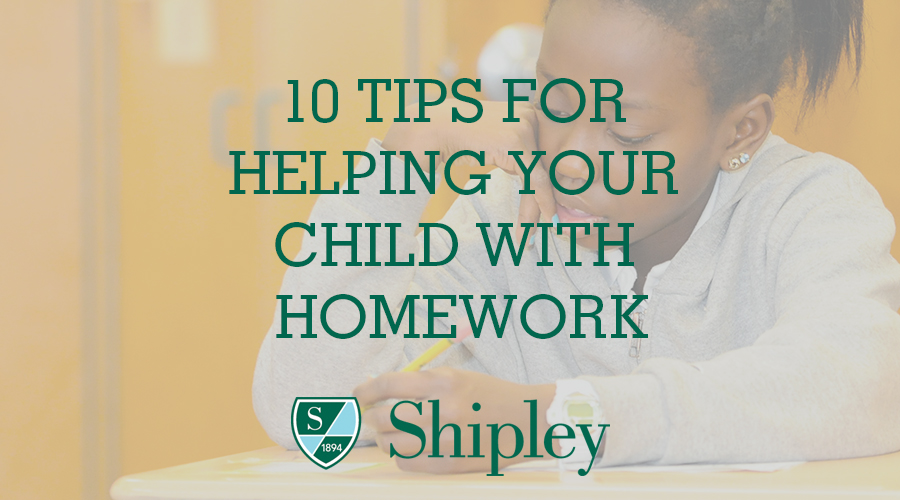1) Gauge your involvement based on what your child’s academic behavior is showing you and not just what your child is telling you.
Leave your successful student alone!
As a parent, you have to determine when your help is both necessary and useful and when it simply complicates an already stressful situation for your child. If your child says that he is doing the work and/or studying well for tests and the grades and teacher comments support that, believe him and go do something else (in another room)! Your child has proven that he can be an effective student on his own and you can leave him alone. While this can hurt your feelings as a parent, you want your child to be independent. You can always remind him that you are there if he needs you.
Trust what your child’s teachers have to say.
If, however, your child’s grades and the teacher comments do not support her story that she has done everything on time and accurately, believe the teachers. Teachers are not going to make up situations where your child is not meeting expectations. Avoid the urge to make excuses for your child. If a teacher talks to you or your child’s grades are slipping, you need to let her know that you will be increasing your involvement in the homework process until you see marked improvement. You, as the parent, get to determine what that means. However, be realistic or he will lose all motivation. Reasonable expectations include completing work in a more public place, or showing a parent completed homework in that subject area every night for a specific period of time.
Offer additional support if your child is putting in the effort and not seeing results.
If your son says that he studied for hours for the math test but failed it, you, as a parent, need to step in. You can say that while you believe that he studied, it is clear that he needs additional help. Giving him some ownership of this review process will make him more open to it. Let him know that if he does not want that person to be you (and don’t be surprised if he doesn’t) tell him that is fine, as long as he identifies a person he would like to work with. It can be a teacher, tutor, or advisor, as long as that person is an expert in that subject area. Do not fall for him naming another student who is going to “help him study.” It is unlikely that he will receive the help he needs from a peer, mainly because most kids are unlikely to admit to others that they are falling behind.
2) Make sure your advice on studying and your approach to learning is based on how your child learns and NOT on how you learn.
You might have a fantastic working memory that you have relied on your entire life. If you insist that your child remember things the way that you do, and she did not inherit that particular memory gene, you are setting her up to feel inadequate in that regard. You might be visual, where your child is verbal. She might need to “talk out a problem” while you need to write it out. Whatever it is that you are helping your child with, always ask her, “What kind of help would be the most useful for you? Would you rather I make a chart, talk it through with you, or show you examples?” You might be surprised at what she needs. It also helps when you point out your child’s strengths, especially if it is not one of yours. It will make your child more apt to utilize that strength in the future.
Take a quick quiz to find out what learning style you are at http://vark-learn.com/the-vark-questionnaire/
Let your children choose their supplies and set up their workspaces.
Insisting that your children study the way you did is not always in their best interest. For example, if you go to an office supply store and buy all of the supplies you think they need and set up their workspaces in the way you feel would be the most useful, it might be marginally appealing to them. If, however, you take them to the store with you and give them a budget, letting them both pick out and organize their supplies, chances are they will be significantly more attached to the workspace. Parents might need to practice restraint on this one. Yes, you might write neater, but if they write on their binders, they own them. If you have an idea for their workspace, they have the right to veto it. Just think to yourself, would you like someone (anyone) to come into your office or home and furnish and decorate it for you without your input? If they did, would you be as proud of it as you would be if you did it yourself?
Base your help on how a concept was presented in class.
Read your child’s textbooks or the class notes to see how he was taught to do the problem before helping. Yes, things are taught differently than when we were in school and if you insist your child try solving problems or completing things your way, he will most likely have to “unlearn” that method and learn the teacher’s way in order to build on that skill in the way the class will ask them to.
3) Keep your hands off the project, keyboard, pencil, or pen!
Resist the urge to contribute complete ideas or help to the actual production of your child’s work. Advising is very different than editing, which is different than ghost writing. The quality of the homework your child is turning in is NOT a reflection of you as a parent. By editing it until it is perfect, or interjecting your “spin” on it until it reads like a graduate level dissertation puts your child at a big disadvantage.
Let your child make mistakes on homework and assignments.
Teachers use homework and drafts as gauges of each child’s level of understanding of material. When parents edit or contribute to it, teachers can no longer use that assignment as a formative assessment of what a child does or does not understand. Teachers might look at the paper and see that everything is spelled correctly, for example, and therefore, not focus on spelling frequently used words with that student. In reality, the parent changed all of those words, so the child is left not knowing how to spell them, or even worse, left without the ability to see that the words were misspelled in the first place. More often than not, teachers know when the work is done by a parent, and are then forced to disregard its content for formative purposes. That child is then left with one less piece of data informing the teacher of what he or she really needs to focus on.
Do not type your child’s assignment for her.
Yes, this means you can’t “just type what she says out loud.” As an adult, we edit as we type and inevitably make corrections. This sort of help enables children to not have to learn to think while producing work, which is something they will absolutely have to learn. Just ask yourself, “Is my help going to serve my child well when I am not around?” If the answer is no, don’t do it.
Allow your child to learn kinesthetically—let him do the work.
Lastly, when your child asks for help, do not grab the pencil or keyboard!!! Children are innately kinesthetic and many of them gain understanding by trying things as they are listening to or watching them being explained. If you take over the writing instrument or computer keyboard, you take away this opportunity for kinesthetic practice. Get your own pencil and let them work with you.
4) Don’t ask a preteen or teenager yes or no questions if you want more than a yes or no answer.
If you give children the chance to get out of a conversation with a one-word answer, they will take it. Rather than asking, “Did you do your homework,” consider asking, “What was the easiest part of the math homework tonight?” When they respond with two words, force them to elaborate by asking them, “Why?” Children often fail to recognize that homework has a purpose and it’s not there simply to make their lives difficult. This is why one of my favorite questions to ask a child is, “Why do you think your teacher assigned this as homework?” Keep pressing them to give you an honest answer after they initially reply with, “Because they don’t like us.”
5) Discuss and establish definitions for the terms “studying” and “homework” in your house before the school year begins.
Think about the last time you asked your child to clean her room. Upon inspection, the room was far from your definition of clean. She probably wasn’t trying to pull a fast one on you, but her definition of clean is different from yours. This is why you need to define what clean means to both of you ahead of time. It might involve a short list like this:
- Bed made and clothes either folded in drawers or in the hamper
- Nothing on the furniture
- Nothing under the bed
- Nothing in the room that could potentially spoil, rot, smell or mildew
A list of what completed homework means might look like this:
- Meets all expectations (answer all questions asked and or meet all criteria presented in assignment description)
- Is on time
- Is legible
- Is in the desired format specified by the teacher (hard copy, email, shared on Google Drive, etc.)
- In the "turn in" folder in backpack (not on desk where it might be left)
Once rules and expectations have been established and mutually agreed upon, the process will be more peaceful. This is also true with homework. If children know the guidelines and expectations in advance, the daily battles will subside.
6) Set minimum time limits for homework completion.
If your child always has an excuse as to why he can’t do his homework, establish a minimum amount of time he must spend in his workspace each night, regardless of whether or not he is prepared. Kids occasionally forget things or have valid reasons for why they cannot get things done on time, but if there is a pattern of homework avoidance that is supported by low homework grades or teacher concern, establish a time minimum. Ask your child’s teachers how much time your child needs to spend on homework each night. If it is 40 minutes, for example, make it clear that he needs to sit there for that amount of time every day, regardless of whether or not he brought the correct books home or if he left his binder at school. It is amazing how much more responsible students become about their belongings when they realize that “forgetting” them doesn't mean not having to do the work. This also works well for children who tend to do the bare minimum. If they know they have to sit there, chances are that they will pull out their work and elaborate on it. This is one of those strategies that does not go over well initially with the child, so sometimes you might need to let him know that the 40 minutes begins when he stops complaining.
This is also a great opportunity for you to apply his behavior to a real-life situation that you would encounter as an adult. Ask your child what would happen if you went to work on a day that a proposal was due and said, “I forgot it at home.” That’s an adult reality and we know how badly these children want to be treated like adults.
7) Set realistic expectations for success and failure by letting your child make mistakes.
School is preparation for life. If we provide support and guidance at the right levels, we teach children how to be independent learners, strong self-advocates and creative problem solvers. If we hover over them, make excuses for their failures, and enable them by taking away natural consequences for their behaviors, we set them up for disappointment. They do not learn perseverance.
Children who rarely experience failure or disappointment often grow up with a false sense of invincibility combined with a unrealistic belief that things will always work out for them in the long run without increased effort on their part because that is how the world has always worked for them. We do not want to teach children to always externalize their failures as the fault of someone or something else (i.e. I failed because that test was so hard) and internalize their successes (i.e. I aced that test because I am awesome). We also do not want to encourage the opposite, which involves internalizing failures (I failed because I am stupid) and externalizing successes (i.e. I did well because the test was easy). We need a combination of both. We need students to realize that there are things in life in our control and things in life that are not. There are things that people are inherently good at and things that take practice.
8) Work with your child to discover her learning style.
Talk to you child. Ask her what she needs to help her learn. Teach children about learning styles and have them research how they learn. Make them proud of how they learn and encourage them to use that as a filter through which they make all of their educational decisions.
9) Don’t give unsolicited help.
The “too involved parent” often, if not always, insists on helping even though the child has not asked for help. This unsolicited advice inevitably leaves the child feeling as though the parent does not have faith in his ability to produce quality work on his own, which ultimately leads to low academic self-confidence.
10) Ask yourself: Is my involvement in this process helping my child to be more successful when I am not around?
If parents use this as their mantra and are honest with themselves when the answer is no, they are likely to be successful in maintaining balance. Remember, your child’s college dorm room will be too small for the both of you! She will have to know how to survive and be her best academic self all by herself some day.










